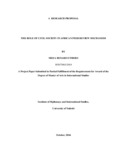| dc.contributor.author | Meda, Benard O | |
| dc.date.accessioned | 2017-01-11T09:40:05Z | |
| dc.date.available | 2017-01-11T09:40:05Z | |
| dc.date.issued | 2016 | |
| dc.identifier.uri | http://hdl.handle.net/11295/100309 | |
| dc.description.abstract | The study is about CSOs involvement in the APRM process. The main objective is to examine and evaluate APRM‟s existence for the last thirteen years, look at the gains and drawbacks that the mechanism has encountered. Basically to assess whether the mechanism has been able to live by its principles and aspirations as discussed in chapter two of the study.
Chapter three of the study interrogates CSOs involvement in the mechanism. It analyzes the mechanism structure and CSOs presence within the different structures of the APRM. It basically seeks to evaluate the relationship between CSOs and the entire components of the APRM. Chapter four on the other hand exposes the strategies that CSOs use to engage the mechanism, it seeks to evaluate whether the tools being used are effective or inept when it comes to influencing the entire APRM mechanism. The chapter also gives a synopsis of the strategies CSOs should use when it comes to lobbying within the mechanism. The chapter basically outlines CSOs role in the Mechanism.
The data in the study was collected through both primary and secondary means. Primary sources comprised field and conference interviews with officials from various Pan African CSOs during APRM conferences and workshops. Focus group discussions were held through the APRM Youth Working Group Kenya.
Study findings show that APRM is growing gradually and by 2020 it will have gathered full momentum to operate effectively. The secretariat among other key stakeholders have drafted a five year revitalization strategic plan(2016 – 2020) that will see the mechanism attract more membership and an increase on its operational framework. CSOs presence within the mechanism is low but gradually growing.
The study recommends that more civic engagements should be conducted to popularize the mechanism and promote popular participation in the process. APR Forum and secretariat should develop a strategy of luring more AU members into the mechanism. APRM member states should also be encouraged to reaffirm their commitment to the country self-assessment review process, they also need to honor their financial obligations promptly | en_US |
| dc.language.iso | en | en_US |
| dc.publisher | University of Nairobi | en_US |
| dc.rights | Attribution-NonCommercial-NoDerivs 3.0 United States | * |
| dc.rights.uri | http://creativecommons.org/licenses/by-nc-nd/3.0/us/ | * |
| dc.subject | The Role Of Civil Society In African Peer Review Mechanism | en_US |
| dc.title | The Role Of Civil Society In African Peer Review Mechanism | en_US |
| dc.type | Thesis | en_US |



